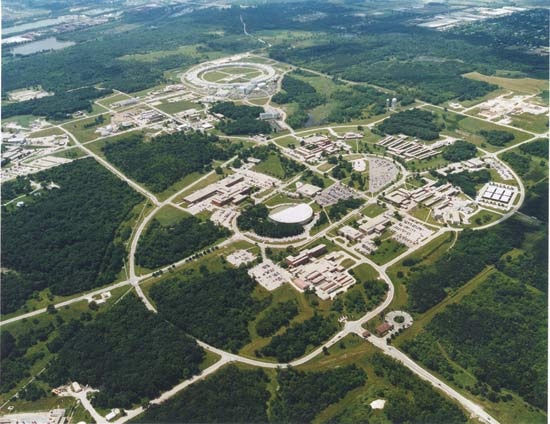Argonne National Laboratory
laboratory, Argonne, Illinois, United States
 the first U.S. national research laboratory, located in Argonne, Illinois, some 40 km (25 miles) southwest of Chicago, and operated by the University of Chicago (Chicago, University of) for the U.S. Department of Energy. It was founded in 1946 to conduct basic nuclear physics (physics) research and to develop the technology for peaceful uses of nuclear energy. Argonne National Laboratory now supports more than 200 basic and applied research programs—in science, engineering, and technology—that are directed to maintain basic scientific leadership, guide energy-resource development, improve nuclear-energy technology, and promote environmental-risk management.
the first U.S. national research laboratory, located in Argonne, Illinois, some 40 km (25 miles) southwest of Chicago, and operated by the University of Chicago (Chicago, University of) for the U.S. Department of Energy. It was founded in 1946 to conduct basic nuclear physics (physics) research and to develop the technology for peaceful uses of nuclear energy. Argonne National Laboratory now supports more than 200 basic and applied research programs—in science, engineering, and technology—that are directed to maintain basic scientific leadership, guide energy-resource development, improve nuclear-energy technology, and promote environmental-risk management.The Argonne laboratory houses several major research facilities that are available for collaborative and interdisciplinary use by government, academic, and industrial scientists. Four of these facilities—the Advanced Photon Source (APS), the Intense Pulsed Neutron Source (IPNS), the Argonne Tandem Linear Accelerator System (ATLAS), and the High-Voltage Electron Microscope- (HVEM-) Tandem Facility—have been designated official U.S. Department of Energy National User Facilities.
The APS, which opened in 1996, is a 7-gigaelectron volt (electron volt) (GeV) synchrotron particle accelerator that is designed to produce brilliant (highly collimated) and intense beams of high-energy X-ray synchrotron radiation for advanced X-ray imaging and diffraction (X-ray diffraction) studies. Using the APS, scientists have performed X-ray diffraction analyses to unravel the structures of complex biological supramolecular assemblies, including ribosomes (ribosome), enzyme-inhibitor (inhibition) (drug) complexes, and bacterial toxins (toxin).
ATLAS is a superconducting linear accelerator that accelerates beams of heavy ions (ion) up to and including uranium for high-energy nuclear physics (physics) research. One example of this work involves experiments to probe the details of nuclear structure in order to answer fundamental questions concerning nuclear stability (isotope). The IPNS provides a powerful source of neutrons (neutron) for neutron-scattering experiments in materials science research; applications include high-temperature ceramics (industrial ceramics) and advanced superconducting materials. The HVEM-Tandem Facility combines electron microscopy (electron microscope) with ion-beam irradiation to study, for example, high-temperature superconductors (superconductivity).
- Alexander Robertus Todd Todd, Baron
- Alexander romance
- Alexander Ross Clarke
- Alexander, Samuel
- Alexander Scott
- Alexander, secundus Monro
- Alexander Selkirk
- Alexander, Shaun
- Alexanderson, Ernst F.W.
- Alexander Spotswood
- Alexander Stewart Albany, duke of
- Alexander Stewart, duke of Albany
- Alexander Tcherepnin
- Alexander the Great
- Alexander The Paphlagonian
- Alexander Turney Stewart
- Alexander (V)
- Alexander VI
- Alexander VII
- Alexander VIII
- Alexander von Humboldt
- Alexander von Kluck
- Alexander Wetmore
- Alexander William Williamson
- Alexander Wilson